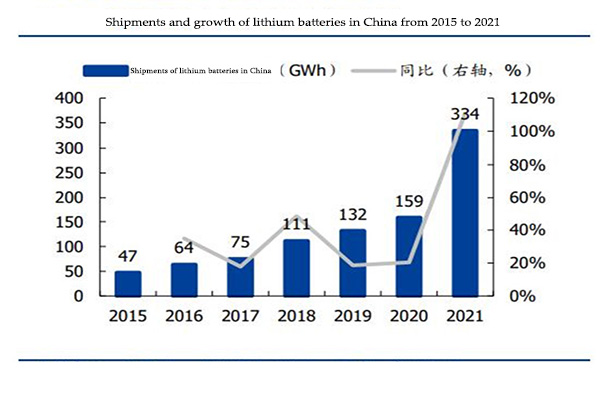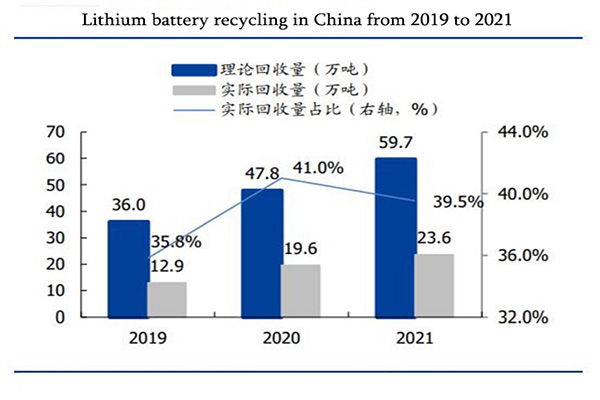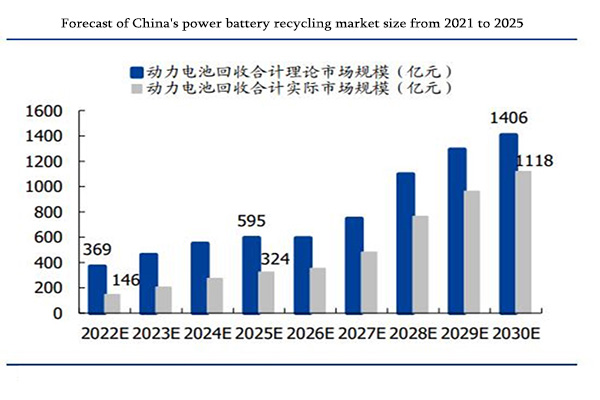The biggest barrier of power battery recycling line is the channel barrier, the difficulty is to collect enough waste batteries at a low cost. Personal scrapped vehicles will become the main source of used power batteries. The supply of power battery(our company provides the automatic assembly line of power battery pack) recycling mainly comes from battery production enterprises, test vehicles of main engine factories, 4S shops for after-sales maintenance and new energy vehicles that have reached the retirement age. At the present stage, most of the recycled batteries come from battery waste from factories or enterprises, and the recycling channels are relatively clear. However, with the coming scrap tide of new energy vehicles, batteries reported by individual owners will become the main component of battery recycling in the future. Battery sources are extensive and dispersed. Green Beauty, a leading scrapped automobile enterprise, only recyles 4% of the total number of scrapped automobiles in China, making it difficult to recycle them.
The construction of power battery recycling system is not standard. Although data from the Ministry of Industry and Information Technology showed that by the end of August 2022, more than 190 enterprises in auto production and comprehensive utilization of power batteries had set up 10,235 recycling service outlets across the country, many of them have not actually carried out the business. At present, power battery recycling mainly comes from the waste power battery generated by research, development, testing and manufacturing, and the real recycling of retired batteries from new energy vehicles is very few. Power battery recycling channel capacity has become an important factor to restrict the profitability of power battery recycling enterprises.

Comprehensive development history of lithium battery recycling at home and abroad, there are currently three mainstream business models: battery (material) manufacturer-based recycling, industry alliance and third-party professional company recycling. Battery (material) manufacturer-dominated recycling mode. The power battery manufacturer is the main body of recycling, and uses the sales service of the electric vehicle manufacturer to build the recycling channel. The electric vehicle manufacturer, seller and consumer cooperate with the battery recycling mode. The characteristics of this model are that battery manufacturers are relatively familiar with their own products, and the recycling technology is relatively difficult and the cost is low. However, the recycling strength of individual enterprises is limited and the channels are relatively single and narrow, and the battery manufacturers are under great capital turnover pressure.
Industry alliance recycling model. It consists of power battery manufacturers, electric vehicle manufacturers or battery leasing enterprises in the industry, and jointly contribute funds to establish a special recycling organization responsible for power battery recycling. This model is characterized by strong market influence and more extensive and diversified recycling channels. However, this model requires higher cooperation among enterprises and its development is not perfect. Third party professional company recycling mode. Battery manufacturers entrust the recycling business to the third party enterprises, or by some small workshop type specialized battery recycling enterprises to recycle waste batteries independently. The characteristics of this model are that third-party enterprises independently build the recycling network, and there are problems in transportation and product resold. Moreover, the recycling technology of small workshop recycling enterprises is relatively poor, and it is difficult to ensure the quality of remanufactured products.
Multi-party business models are expected to become mainstream. By comparing the advantages and disadvantages of the above three business models, taking into account the importance of broadening battery recycling channels, reducing recycling costs and the advantages of complementary technologies, we believe that in the future, China's dynamic battery recycling industry is more likely to form a multi-party cooperation business model of battery manufacturers, automobile enterprises and professional recycling organizations, and build a closed loop of the power battery industry chain.
3.1. The United States: Perfect policies and institutions, mainly market regulation
The recycling and utilization management of waste batteries and other renewable resources in the United States is mainly regulated by the market. The federal government stipulates the responsibility of battery production enterprises and battery recycling institutions as constraints. The Rechargeable Battery Recycling Corporation of America (RBRC) and the Portable Rechargeable Battery Association of America (PRBA) are the leading union forces for battery recycling in the US market. In terms of policy and system design, the United States has established corresponding laws and regulations at the federal, state and local levels to regulate power battery recycling. The producer responsibility system is adopted in the system, and the deposit system is encouraged by industry associations to encourage consumers to hand in waste batteries voluntarily, so as to promote the construction of power battery recycling network.
At the recycling level, there are professional technology research and development enterprises, which provide corresponding technical specifications for the production, collection, transportation and storage of waste batteries. At the capital level, consumers need to pay a certain amount of commission fee (government additional environmental fee) when purchasing batteries as part of the recovery funds of the battery manufacturers; Battery manufacturers pay recycling fees to professional recycling enterprises as financial support for cell scrapping recycling, and purchase raw materials purified by professional recycling enterprises at agreed prices; Professional technology research and development enterprises with special funds to carry out research and development of battery recycling technology. This recycling mode in the United States has successfully solved the front-end problems such as low recycling efficiency and poor recycling economy of waste batteries.

3.2 Japan: Legislation and subsidies are combined, and people have a strong sense of recycling
Japan is a country at the forefront of waste battery recycling and disposal, mainly implementing legislation and the system of subsidizing battery enterprises. People have a good sense of independent recycling. In 1994, Japanese battery manufacturers began to initially establish a battery recycling system. Since 2000, the Japanese government has stipulated that decommissioned power batteries should be recycled by battery manufacturers, and the recovered decommissioned batteries should be transported back to battery manufacturers for disposal. The government will give corresponding subsidies to the manufacturers for the funds spent on recycling. Overview of battery recycling patterns in Japan. At the level of policy and system design, Japan has a well-structured, sound and gradual legislative system for circular economy, and has formulated basic systems for a circular society, including the extended producer responsibility system, environmental reporting system, etc., to supervise and monitor the whole process of production, consumption, waste treatment and other links in an all-round way.
At the recycling level, battery manufacturers need to design battery products based on the principle of easy recycling, and the manufacturers are responsible for recycling waste batteries. Japanese manufacturers have established a battery recycling and utilization system of "battery production-sale-recycling-recycling treatment". In terms of funds, consumers do not need to pay more fees to any institution when purchasing power batteries, and they can rent power batteries. The government provides certain subsidies to battery manufacturers. Power battery manufacturers can recycle waste batteries from consumers free of charge by using service networks such as retailers, car sellers, scrap car dismantling enterprises and gas stations, and finally hand them over to professional recycling companies for disposal. The treated battery eventually goes back to the power battery manufacturer to make a new one.
3.3 Germany: Government legislation is the core, and the recycling system is perfect
Germany has established a relatively mature and perfect recycling laws, regulations and operation system. The government is the core of power battery recycling. It adopts producer responsibility system and deposit system, and stipulates that battery manufacturers, sellers and importers must set up recycling points and organize the collection of used batteries.
Overview of battery recycling patterns in Germany. In terms of policy and system design, laws and regulations of circular economy in Germany also follow the principle of extended producer responsibility system, adopt government legislation, establish fund and deposit mechanism for power battery recycling, and clarify the corresponding recycling responsibilities and obligations of battery manufacturers, sellers, recyclers and consumers. At the level of recovery, the government legislates to clarify the responsibility of each link in the production chain from the source. Battery manufacturers and importers must be registered with the government; Dealers participate in organizing the construction of recycling network, cooperate with the government and production enterprises to set up offline recycling outlets, and take the initiative to publicize and introduce free recycling places and related policies to consumers; Consumers are obliged to hand in their used batteries to designated recycling agencies through funds and deposit systems. At the financial level, the German government supports the research on the resource utilization of power batteries and has funded several demonstration projects for power battery recycling, such as LIBRi, LithoRec and LiBinfinity.

3.4 Summary: Perfect laws and regulations and scientific system design promote the standardized development of the industry
Specific and systematic laws and regulations system is the fundamental establishment of a standard waste battery recycling industry chain is the perfect laws and regulations system constraints. Based on the experience of developed countries, specific and systematic laws and regulations can clarify the responsibilities and obligations of battery manufacturers, automobile manufacturers, dealers, consumers, recycling enterprises and other parties to avoid the crossing and confusion of responsibility boundaries, which is the basis for subsequent strict market supervision, so as to ensure the overall orderly development of the battery recycling industry chain. Scientific and efficient mode design is the key to maximize resource utilization efficiency and minimize pollution emission by constructing a scientific and efficient system and mode of battery recycling and realizing the closure of the battery industry chain under a sound legal and regulatory system. Developed countries implement the manufacturer responsibility system by battery unified code, implement the deposit system to encourage consumers to collect and hand in waste batteries, industry association auxiliary battery recovery patterns and measures, effectively ease the front-end battery recovery efficiency low, poor economic problems, to the construction of battery recycling industry chain has a reference value.
The power battery recycling industry still has some problems, such as insufficient policies and regulations, non-standard development. Small and medium-sized enterprises have low investment in safety and environmental protection, and have more advantages than white list enterprises in the purchase price of used batteries, which may cause the risk of bad money driving out good money in the industry. At present, power battery recycling industry policies and regulations are insufficient. Although the Ministry of Industry and Information Technology has published the "new energy vehicle waste power battery comprehensive utilization industry standard conditions" of 88 enterprises, but the policy is only a directive document, not mandatory. According to data from platforms such as Qichacha, the number of registered power battery recycling enterprises in China reached about 24,000 in 2021, far higher than the number of enterprises on the whitelisted by the Ministry of Industry and Information Technology.
In the background of imperfect supervision, small enterprises technology and environmental protection substandard problems are more prominent. 1) At present, small and medium-sized enterprises in the market generally adopt the unified crushing method for recycling resources, that is, the raw materials are put into the feeding hopper and broken into powder and flake, and the copper powder and aluminum powder are recovered by coarse separation of dust. On the one hand, the impurities of copper powder and aluminum powder are high; on the other hand, small and medium-sized enterprises have little investment in safety and environmental protection equipment. It is difficult to invest funds to match the intelligent dismantling system, automatic cutting device, absorber, dust collector and other equipment, and the environmental protection is seriously not up to the standard. Because of the scattered distribution of small enterprises, supervision can not be fully touched, causing obstacles to the standardized development of the industry.
2) In terms of transportation, battery transportation belongs to hazardous waste transportation, and the cost of remote treatment becomes higher due to the transportation cost. Small enterprises cannot amortize the cost by increasing turnover volume. For the business requiring transportation, some non-standard enterprises adopt the mode of "cooperation" with transportation enterprises with hazardous waste transportation qualifications, and operate in the name of hazardous waste transportation enterprises without using special vehicles for hazardous waste. Although the cost is reduced, a huge environmental pollution safety hazard is formed. Referring to the experience of developed countries, along with the standardization of Chinese industry, more batteries are expected to flow into formal enterprises. With the standardization and specification of the policies and regulations of China's power battery recycling industry, the potential environmental protection and technology costs of small and medium-sized enterprises will gradually highlight, and the head enterprises with strong technical capital will gain significant competitive advantages, and with the responsibility system of enterprise recycling step by step clear, more waste batteries are expected to flow into the head formal enterprises.
Contact: Jason Wang
Phone: 13580725992
E-mail: sales@aooser.com
Whatsapp:13580725992
Add: No.429 Guangming Road, Shenzhen City, Guangdong Province
We chat
